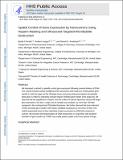| dc.contributor.author | Chertok, Beata | |
| dc.contributor.author | Langer, Robert S | |
| dc.contributor.author | Anderson, Daniel Griffith | |
| dc.date.accessioned | 2019-08-22T15:35:28Z | |
| dc.date.available | 2019-08-22T15:35:28Z | |
| dc.date.issued | 2016-07 | |
| dc.date.submitted | 2016-02 | |
| dc.identifier.issn | 1936-0851 | |
| dc.identifier.issn | 1936-086X | |
| dc.identifier.uri | https://hdl.handle.net/1721.1/122008 | |
| dc.description.abstract | We developed a method to spatially control gene expression following nonviral delivery of DNA. This method includes surface-modifying DNA nanocarriers with heparin to inhibit passive gene transfer in both the target and the off-target tissues and using ultrasound-targeted microbubble destruction (UTMD) to selectively activate heparin-inhibited gene transfer at the target site. We observed that the engraftment of heparin onto the surface of cationic liposomes reduced off-target gene expression in the liver, a major site of nanoplex accumulation, by more than 700-fold compared to the nonheparinized PEGylated liposomes. We further observed that tumor-directed UTMD increased gene transfer with heparin-modified nanoplexes by more than 10-fold. This method augmented tumor-to-liver selectivity of gene expression by 4000-fold compared to controls. We conclude that heparinization of DNA nanocarriers in conjunction with localized activation of gene transfer by UTMD may enable greater spatial control over genetic therapy. Keywords: gene delivery, spatial control, tumor targeting, gene nano carriers, heparin surface masking, microbubbles, ultrasound | en_US |
| dc.description.sponsorship | National Institutes of Health (U.S.) (Grant U54 CA151884) | en_US |
| dc.language.iso | en | |
| dc.publisher | American Chemical Society (ACS) | en_US |
| dc.relation.isversionof | http://dx.doi.org/10.1021/acsnano.6b01199 | en_US |
| dc.rights | Article is made available in accordance with the publisher's policy and may be subject to US copyright law. Please refer to the publisher's site for terms of use. | en_US |
| dc.source | PMC | en_US |
| dc.title | Spatial Control of Gene Expression by Nanocarriers Using Heparin Masking and Ultrasound-Targeted Microbubble Destruction | en_US |
| dc.type | Article | en_US |
| dc.identifier.citation | Chertok, Beata et al. Spatial Control of Gene Expression by Nanocarriers Using Heparin Masking and Ultrasound-Targeted Microbubble Destruction 10, 8 (July 2016): 7267-7278 © 2016 American Chemical Society | en_US |
| dc.contributor.department | Massachusetts Institute of Technology. Department of Chemical Engineering | en_US |
| dc.contributor.department | Massachusetts Institute of Technology. Institute for Medical Engineering & Science | en_US |
| dc.contributor.department | Harvard University--MIT Division of Health Sciences and Technology | en_US |
| dc.contributor.department | Massachusetts Institute of Technology. Department of Biological Engineering | en_US |
| dc.contributor.department | Koch Institute for Integrative Cancer Research at MIT | en_US |
| dc.relation.journal | ACS Nano | en_US |
| dc.eprint.version | Author's final manuscript | en_US |
| dc.type.uri | http://purl.org/eprint/type/JournalArticle | en_US |
| eprint.status | http://purl.org/eprint/status/PeerReviewed | en_US |
| dc.date.updated | 2019-08-09T12:42:12Z | |
| dspace.date.submission | 2019-08-09T12:42:13Z | |
| mit.journal.volume | 10 | en_US |
| mit.journal.issue | 8 | en_US |
